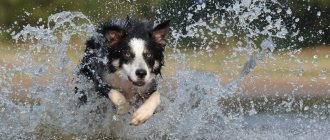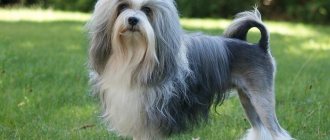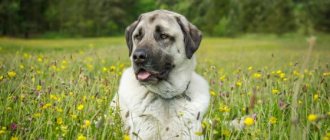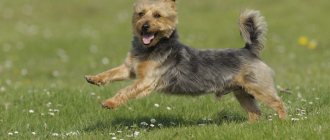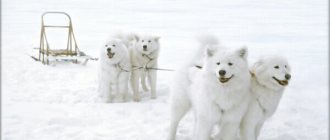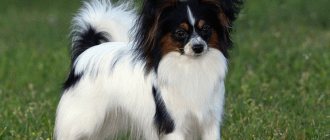| Origin: | Cuba |
| Usage: | Decorative dog; domestic companion dog |
| Color: | White with splashes of black and brown; black; brown; red-red; pure white |
| Dimensions: | Height at withers 21-29 cm. Weight from 3 to 5 kg |
| Lifespan: | 13-16 years old |
The Havanese Bichon (Havanese; Havanese) is the smallest lap dog with a huge heart and a taste for the rich life, which is not surprising. For centuries, she preferred the hands of rich and famous people. Queen Victoria, Charles Dickens, Barbara Walter - they were all crazy about these little furries. What the pet lacks in size, it makes up for with its personal qualities: a very lively, active dog, loves people, and is good for communication.
Breed standard
Very respectable and beautiful, the Havanese or Havanese comes in all the colors of the rainbow. From black and white to chocolate and silver, with all sorts of shade options. But the most distinctive physical feature is the unique silky, glossy coat: long, soft, weightless and serves as protection from the scorching rays of the sun. The table shows the main parameters of the dog.
| Options | Description of the breed |
| Head | Medium size, proportional to the length of the entire body. |
| Muzzle | Wedge-shaped, tapering evenly towards the tip of the nose. |
| Neck | Medium size, smooth transition to the withers. |
| Ears | Long, hanging, high set. Covered with wavy fur. |
| Eyes | Large, almond-shaped. The color of the iris is dark brown. The eyelids have a dark edging. |
| Cheekbones | They don't stand out. |
| Nose | The nasal planum is dark brown or black. |
| Lips | Tightly fitting, thin, with a clear edge. |
| Bite | Scissor-shaped. A full set of teeth is desirable. |
| Frame | The back is straight, slightly raised at the withers, and lowered at the lower back. The belly is lean. |
| Limbs | Straight, graceful forelimbs. The hind limbs are longer than the forelimbs, strong, but not powerful. |
| Paws | In the shape of an oval, the fingers are tightly closed into a ball. |
| Wool | The undercoat is poorly developed or not at all. The coat is silky, wavy or straight. |
| Tail | Raised high, saber-shaped or curled into a ring. |
| Color | White. Presence of spots of different colors. |
| Movements | Lightweight, fast. The hind legs provide the propulsion force for movement. Forelegs – precise straight movements. |
The Havanese Bichon dog breed is subject to disqualification if the following signs are present:
- Incomplete set of teeth.
- Bite: overshot or undershot.
- Absence or weak pigmentation of the skin of the lips and around the eyelids.
- Coarse wool or subject to trimming or shearing.
- Straight hanging tail.
- Deformation (curvature) of the paws.
- Small, deep-set eyes.
- Eye color other than dark brown.
Description and characteristics
Small dog breeds are increasingly being chosen as pets. They are easy to start in a small apartment and much easier to care for. The Havanese Bichon has long been winning the hearts of dog lovers - a breed with an interesting history and cute appearance.
- Country of origin: Cuba.
- Size: small.
- Height: 21-29 cm.
- Weight: 3-5.5 kg.
- Color: white, black, silver, gold, red, cream, mixed possible.
- Coat length: long.
- Shedding: weak.
- Life expectancy: up to 15 years.
- Group: decorative dogs and companion dogs.
- Recognized by: CKC, FCI, AKC, UKC, ANKS, NКC, APRI, ACR.
- Litter: from 1 to 9 puppies, on average - 4.
For urban conditions, Chinese crested dogs, pugs, Pekingese, Pomeranians, dachshunds, toy terriers, Yorkshire terriers, French bulldogs, Chihuahuas, Maltipoos, Maltese dogs, colored lap dogs, and toy poodles are suitable.
Appearance and photo
The Havanese Bichon is considered an aristocratic dog - just look at its proud appearance. The dog itself is small, compactly built, and has a strong bone frame. The legs are short, the tail is ringed, and the ears droop. It is the coat that gives dogs a special charm - it is thick, shiny, and long. The color can vary depending on the pedigree - Havaneses with black-golden, black-and-white coats are often found. Very rarely they are pure white; most often, silver wool is found.
Did you know? Dogs are not recommended to eat sweets, and chocolate is poison for them and can generally kill them.
Proportions play an important role in the appearance of Bichons:
- muzzle (its length is equal to the distance between the occipital protuberance and the base of the nose);
- head (its size is equal to 3/7 of the dog’s body);
- body (the length from the shoulder to the buttock corresponds to the height at the withers 4/3).
Character
The Havanese has a friendly and affectionate character. The dog is sociable, not nervous, calm and very intelligent, which is not always characteristic of small breeds. If you train her, she will carry out various commands no worse than her larger brothers.
This breed easily adapts to different conditions, it constantly needs communication, so it is better to get such dogs for those who have enough free time - pensioners, families with children, people with remote work.
Important! Havanese should not be isolated from people for more than a few hours. Because of this, the dog begins to get nervous and behave unpredictably.
Character
The Havanese Bichon is distinguished by its flexibility and high mental abilities. Shows healthy wariness towards strangers, but is devoid of aggression. A decorative dog requires indoor keeping. An ideal option for a pet whose maintenance is planned in small rooms, small apartments.
They require increased attention from the owner and family members. Alone, he will feel sad and show his sadness by damaging things. Therefore, it is not advisable to leave the dog alone for a long time, especially at night.
Education and training
Havanese Bichons are easy to train and even beginners can handle it. Dogs of this breed are smart and love to learn, so they can quickly master a large number of tricks. The dog is still learning the basic habits (to relieve himself in the litter box, sleep in his place, don’t beg, don’t bother the owner, don’t spoil things) and commands (“Come to me!”, “Near!”, “Sit!”) for participation in exhibitions. in puppyhood, and does it without difficulty. Suitable for agility and flyball. In addition to the functions of a pet, the Havanese can be trained to be a guide for the blind and a termite and mold detector.
Application
The Bichon is widely used as a companion for single people. A dog will brighten up the loneliness of an elderly person; in addition, close communication with an animal is beneficial for the owner’s well-being.
Kinestherapy is one of the newfangled branches of alternative medicine. Many balneological centers use the method of treatment by communicating with animals. The Havanese Bichon dog breed is considered the most promising in this direction.
The beneficial effects of contact with animals on the activity of the nervous and cardiovascular systems have been scientifically proven. In a family with children, the dog will become a friend in games, and sometimes in pranks. The dog is ready to have endless fun, which brings him closer to children. Although the Bichon is small in size, it can very well play the role of a watchman. A ringing and loud bark will warn the family that guests are approaching.
Story
It is believed that the Havanese originated from a cross between a Bolognese and a poodle or is descended from a Maltese dog.
Lapdogs were popular among the aristocrats of Cuba, but despite high patronage, they almost became extinct at the beginning of the 20th century after the Cuban revolution. They were saved from extinction by US dog breeders who loved to breed these beautiful dogs.
At the end of the 20th century, the lapdog ended up in Europe. She, looking like a powder puff, was noticed. Soon she began to constantly participate in exhibitions.
Of course, the Havanese Bichon, rescued by the Americans, is significantly different from the Cuban breed.
Socialization
Thanks to their loving nature and playful disposition, Bologneses get along well with other pets. And it doesn’t matter whether they grew up together or appeared in the house at different times. For the Bichon, the most important thing is src=»https://dogipediya.ru/wp-content/uploads/2019/01/gavanez-4.jpg» class=»aligncenter» width=»583″ height=»480″[/img ]
The Havanese Bichon is better with children than other dog breeds. But it is more desirable if the child is a schoolboy. Due to his age, the baby is not able to calculate his strength and may accidentally harm the dog. She, in turn, will yap or even bite lightly.
Other pets and children
The Havanese Bichon is a wonderful family dog that is affectionate with everyone, including children of all ages and other pets. But due to their small size, they can easily get injured, so it is important to teach your children how to properly handle a dog.
You should always supervise any interactions between dogs and small children to prevent injury to both parties. Teach your child not to approach any dog while it is eating or sleeping. No dog, no matter how friendly, should be left alone with a small child.
Features of maintenance and care
The Havanese or Havanese is an indoor animal. Pets for the city and apartment, need average loads, but can adapt to any conditions. If you get a Bichon to live in a rural house and take long walks through wooded areas, you need to take into account that the dog’s hair will collect all the leaves, blades of grass and other debris.
Grooming
A person who decides to get a Havanese Bichon will have to make friends with a comb and use it two or three times a day. If you don’t have the time or desire to take care of your pet, then it’s better to think about another breed.
This dog does not need to be cut or trimmed. Her natural state of being disheveled and disheveled is highly prized in exhibitions and exhibitions.
The eyes need extra attention. Thick hair that falls all over the face can cause inflammation of the mucous membrane. Eyes should be wiped every day with a cotton pad soaked in water.
Walk
To satisfy its natural needs, it is enough to take your pet for a walk in the morning and evening. It is advisable to teach your pet to wear a diaper from an early age. In this case, there will be no unpleasant incidents in the form of a puddle on the floor if, for example, in case of bad weather the owner does not want to go out into the yard. By the way, the Havanese is a dog that is ready to stay in a warm house in bad weather.
Feeding
The Havanese Bichon is a decorative dog. Luxurious wool is the hallmark of the breed. To maintain the coat in presentable condition, the dog must receive proper nutrition.
The basis of the diet is meat, as well as offal. You can replenish your supply of vitamins with vegetables and fruits. All food is given boiled. It is unacceptable to feed the dog from the owner's table, or to allow it to beg for pieces outside the allotted feeding time.
Little Havanese is prone to gluttony, and this leads to excess weight and related diseases.
The Havanese Bichon dog breed is quite unpretentious in food. However, it is unacceptable to feed your dog smoked meats, pickles, citrus fruits, and peppery dishes.
For dry food supporters, it’s enough to simply choose a menu for your pets. Modern industry produces a wide range of products for dogs of all sizes, ages, and taste preferences. Don't skimp on food. Good food cannot be cheap. It is better for the Havanese Bichon to purchase luxury food (super-premium class, holistic).
When feeding dry kibble, your dog should always have access to drinking water.
Feeding
The health and appearance of the Havanese depends on a properly selected diet. The first days after purchasing a puppy, you need to feed him the same food that he ate in the nursery, and then switch to the chosen nutrition system. There are 2 options for feeding Havanese: natural products and ready-made food.
The main component of the Havanese Bichon's diet is meat. Choose lean varieties: beef and poultry. Fish can be given several times a week, choose sea fish and seedless. Cook buckwheat and rice porridge for the animal, and do it in meat broth.
It is better to cut the vegetables into small pieces and boil them. For fermented milk products, offer your dog low-fat cottage cheese, kefir or fermented baked milk. You shouldn’t get carried away with fruits; give them to your lapdog as a treat. You should not feed your dog salty, spicy, smoked or fried foods: this is not only harmful to the dog’s health, but can also negatively affect the appearance of the breed.
Ready-made feed
Ready-made food is produced in the form of dry granules and canned food. Using dry dog food requires the dog's unhindered access to a bowl of drinking water. When choosing ready-made food, special attention should be paid to the age and breed of the animal. The manufacturer usually indicates recommendations for the use of food on the product packaging. This method of feeding is more convenient, but also more expensive.
The nutritional system and balanced diet have a direct impact on the health of the animal, the condition of its coat and life expectancy. This breed is unpretentious not only in maintenance, but also in its diet, which can be of 3 types:
- dry food;
- natural products;
- mixed feeding.
When purchasing ready-made food mixtures, you should give preference only to high-quality food that is made from natural products and does not contain dyes, preservatives or stabilizers, and is also appropriate for the pet’s age. These products must contain the following ingredients:
- turkey;
- salmon;
- duck meat;
- trout;
- lamb meat
When feeding your pet natural products, the following products should be present in the daily menu:
- meat;
- offal;
- vegetables (carrots, pumpkin, zucchini);
- fruits (apples);
- fish;
- cottage cheese;
- kefir;
- yogurt;
- eggs (chicken, quail);
- fish fat;
- salmon oil;
- greenery;
- porridge (rice, oatmeal).
It is strictly forbidden to give your pet the following products:
- fried, smoked, salted and canned food;
- sugar and salt;
- ketchup, mayonnaise and sauces;
- instant food products;
- seasonings;
- citrus;
- tomatoes;
- chocolate;
- confectionery;
- thin chicken bones;
- peas and beans;
- sausage and frankfurters.
Recommended daily intake: 0.5 to 1 cup of high-quality dry food, divided into two doses.
NOTE: The amount of food your dog needs also depends on many other factors, such as his activity level, size, build, age and the quality of the food itself.
Keep your Havanese in good shape. His waist should be visible. A more accurate test: place your hand on the dog's ribs; you should feel the ribs without having to press, but not see them. If you can't do this, then your dog has become fat and needs more exercise and less food.
Health
The Havanese Bichon is a model of longevity, with an average lifespan of 14 years. But with good care they can live up to 16 years, remaining in active physical shape.
Predisposition to a number of diseases:
- Cataract.
- Retinal atrophy.
- Food allergies.
- Otitis.
- Vaccinations.
To avoid contracting life-threatening diseases for dogs, all puppies are vaccinated. The first vaccination is carried out at the age of 8-10 weeks: by this time the innate immunity received by the puppies from the mother subsides.
Standard vaccinations against plague, rabies, hepatitis and other infections are carried out strictly according to schedule, under the supervision of a veterinarian. Action plan (adjustment is possible according to the individual condition of the dog):
- 8-10 weeks. 1st round The first vaccination against plague, enteritis, leptospirosis, and parainfluenza is given.
- 12-14 weeks. 1 round (continued). Revaccination of a previously administered vaccination. Plus a new rabies vaccine.
- 6-7 months. 2nd round of previously administered vaccinations.
- 12 months. 3rd round of previously performed vaccinations.
Next, vaccinations are repeated at intervals of 1 year for the entire life of the pet.
Mating
A week before the expected event, the bitch should be treated for fleas and helminths. It is also better to once again check the records of her vaccinations, because the life and health of future puppies in the first 2 months of life depend on their age.
At the age of 18-24 months, the dog is allowed to be mated for the first time. This applies to both males and females. Mating earlier will not lead to good offspring, because all the dog’s organs and systems mature no earlier than one and a half years.
The dogs are not fed on the day of mating. For the “wedding” the bitch arrives at the dog’s territory. The animals are given time to get to know each other. Most likely, for an inexperienced dog, you will have to hire a specially trained instructor who will correctly guide the dog. It is recommended to repeat the mating after two days to consolidate the result.
The vaccine is given to the bitch 3 months before the expected mating. Late vaccination can contribute to the appearance of defects in puppies.
Nutrition
The Havanese Bichon can eat both dry and natural food. However, meat products are preferable. Some Havanese love fruit. It is not allowed to feed them food from the table.
Their diet should be balanced. Feed an adult Bichon 2 times a day, remembering to fill the bowl with fresh water.
Puppies are fed intensively 6 times a day. Select foods that are high in calories and rich in easily digestible protein.
Along with food, puppies are fed calcium supplements. Once puppies reach 6 months of age, they begin to grow a little slower and can be gradually introduced to three meals a day.
- Sweets, sausages and fried foods should be excluded from the Bichon's diet.
How much do Havanese Bichon puppies cost?
The average price for a two-month-old puppy is $400 and up. There is an opinion that in Russia, under the guise of Havanese Bichons, discarded individuals of various lap dogs are sold.
There is no reliable information about the presence of professional nurseries in Russia. Therefore, to purchase, you will have to contact nurseries in Europe or America, where the Havanese Bichon dog breed is most popular.
- Nursery in Latvia: https://oazehavana.lt/ru.
You can look for private breeders, but no one will give any guarantee regarding the uniqueness of the breed. A charming, loving, intelligent Havanese Bichon dog is destined to decorate the world. Its unpretentiousness in maintenance and care makes it attractive for purchase.
Choosing a puppy
Havanese dogs are most popular in the United States; most nurseries for breeding them are located there. In our country, this breed is rare, but nevertheless, puppies can be found. You should only purchase a baby from a trusted breeder with a good reputation and positive reviews.
Havanese puppies are difficult, but can be found.
It is very difficult to distinguish a small Havanese from other adjacent breeds or just a similar outbred animal, since the puppies of all lapdogs are very similar. Only supporting documents (parental pedigrees, puppy records, etc.) can serve as a guarantee of purebredness.
It is better to avoid buying a cute Havanese dog at a bird market or in a subway passage at a very attractive price, since purebred puppies of this rare breed are not sold that way.
Price of a puppy of this breed
The cost of Havanese babies ranges from 20-40 thousand rubles, it all depends on the birth and title of the parent couple, as well as on the prospects of the upcoming exhibition activities. For show class puppies they ask for more (up to 70 thousand). A pet without documents can be found for 8–10 thousand rubles.
